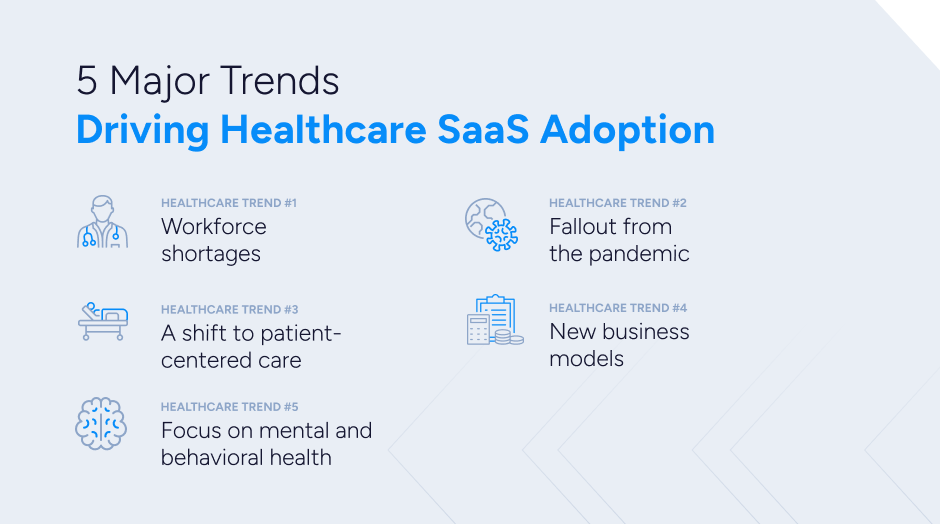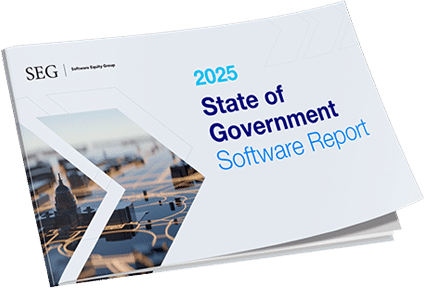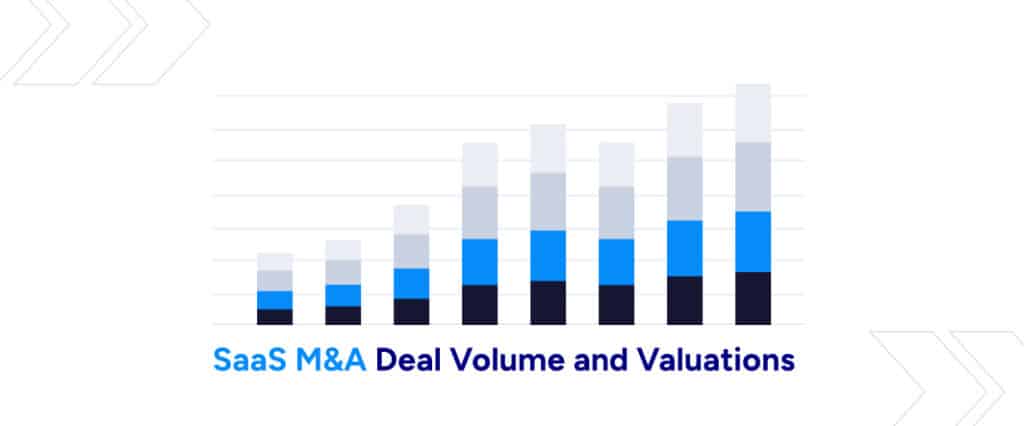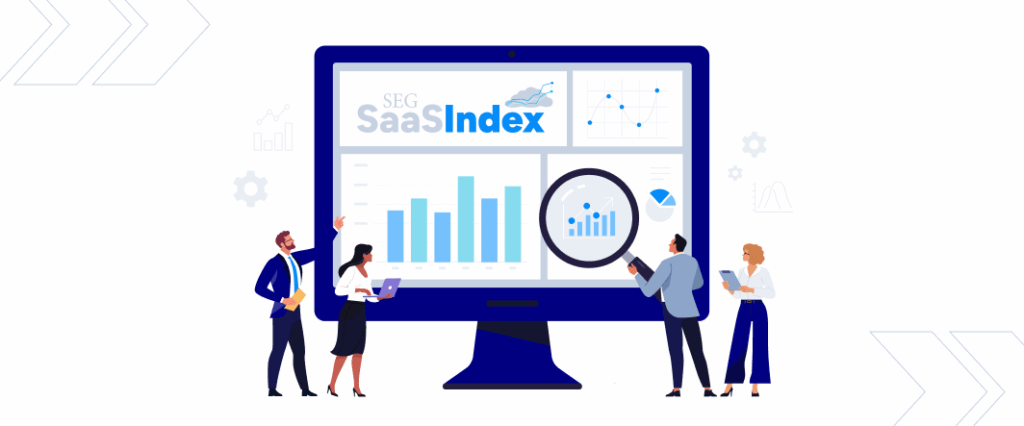The SaaS Prescription: Healthcare Trends and M&A Insights

Few would disagree the American healthcare sector faces a great many challenges in terms of accessibility, affordability, and quality of care.
Digital transformation is central in streamlining many healthcare processes, simplifying the consumer experience, and driving down costs across the board. Healthcare SaaS solutions serve as the interface to make it all possible, and they will continue to proliferate in the ensuing years. The accelerating adoption of healthcare SaaS products is creating a new wave of opportunity for SaaS business owners, whether they’re pursuing revenue growth or exploring potential exit opportunities.
As an advisor to SaaS entrepreneurs, SEG keeps close watch of trends impacting the industry and its vertical markets. In this post, we’ll offer further insights into what’s driving the need for healthcare SaaS solutions and how business owners can capitalize on heightened activity in healthcare M&A.
5 Major Trends Driving Healthcare SaaS Adoption
Despite millions of dedicated and hardworking healthcare workers doing their best, the complexity and inefficiencies of the healthcare system leave far too many consumers frustrated, confused, and unable to afford proper treatment. While these problems are nothing new, they’ve been exacerbated in recent years by the disruptions of the COVID-19 pandemic and rampant inflation, among other issues. The good news is there is light at the end of the tunnel, largely thanks to the evolution of technology.
Simply put, U.S. healthcare is in critical condition and needs help, in many different ways, and in a hurry. Costs are out of control: the U.S. spends nearly 18% of its GDP on healthcare, far more than any other peer country. Between January 2000 and December 2022, the cost of hospital services rose 227%, faster than any other spending category. Despite sky-high costs, healthcare outcomes in the U.S. are no better than other nations — and are much worse in several categories. Among other woes, life expectancy is lower in America, avoidable deaths are higher, and obesity rates top the charts.
These hard truths go hand-in-hand with several pervasive healthcare trends, each of which is strengthening the business case for healthcare SaaS solutions:

Trend #1. Workforce shortages
A scarcity of qualified healthcare workers, especially in home health and nursing, is a pressing concern. In addition to public strategies to reduce the shortage, technological solutions are needed to help fill the gaps.
Trend #2. Fallout from the pandemic
When the world went into lockdown, people put off going to their doctors for non-emergency tests and elective procedures. Healthcare organizations suffered from the sudden loss of revenue, and now, as government subsidies have ended and inflation remains high, they are desperate for solutions that help them cut costs and increase efficiency.
Trend #3. A shift to patient-centered care
A growing body of research and consumer demand are pushing healthcare organizations to adopt a more personalized, collaborative, comprehensive approach to caring for patients’ whole-health needs. Along these lines, the increasingly popular practice of “precision medicine” creates tailored treatment plans based on patients’ unique risk factors. The evolution of care will depend on software to assist physicians in understanding patient needs, developing treatment plans, and facilitating ongoing conversations.
Trend #4. New business models
As part of the patient-centered approach, providers are beginning to offer more ambulatory (i.e., mobile) care options to make healthcare more cost-effective and convenient, including software-driven solutions such as telehealth, wearable device monitoring, and mobile apps.
Trend #5. The focus on mental and behavioral health
The world’s collective medical knowledge continues to grow and evolve, and today, the healthcare community is placing greater emphasis on the inextricable relationship between physical and mental well-being. Using technology as another tool to address these needs more effectively could go a long way toward improving outcomes and reducing costs.
Healthcare M&A Activity Benefiting SaaS Businesses
Compared to other industries, healthcare has been relatively slow to adopt new technologies through the years, but that’s changing due to the urgent need to address the many woes of the healthcare system. As technology becomes increasingly integral to streamlining operations and delivering efficient, patient-centric care, people are recognizing the immense potential for innovation in healthcare software. Thus, these realities are also driving a surge of M&A activity in the healthcare SaaS arena. In 2022 and 2023, a time when M&A transactions in many industries declined due to economic conditions, healthcare M&A deals increased considerably.
SEE THE LATEST HEALTHCARE SaaS M&A TRANSACTIONS
This burgeoning interest is not solely driven by market dynamics; rather, it is also supported by the profound significance of healthcare itself. Unlike other industry verticals, healthcare is inherently vital, directly impacting individuals’ well-being and quality of life. Consequently, the need to enhance healthcare infrastructure and delivery through SaaS solutions is not just a business opportunity but a moral imperative, making healthcare SaaS M&A a crucial avenue for catalyzing positive change in an industry that plays a fundamental role in societal welfare.
Urgency Drives Healthy M&A Valuations
Beyond the standard financial metrics that typically create valuations in any industry, the healthcare sector has several distinctive elements that significantly contribute to its valuation dynamics.
First is the mission-critical role that healthcare software plays in modernizing the healthcare system. Unlike many industries where software is deemed a “nice to have,” healthcare software is often recognized as a “need to have.”
Secondly, the healthcare industry enjoys a built-in customer base that only continues to grow. After all, everyone needs healthcare, especially America’s massive population of aging baby boomers.
Finally , the stringent regulatory environment in healthcare demands that organizations maintain a strong compliance framework and are willing to pay for software solutions that help them reduce risk.
The Limitless Possibilities for Healthcare Software
Digital transformation (DX) is sweeping across every industry. However, healthcare may be the arena where DX, facilitated by advanced software, can have the most meaningful and positive impact, especially on the United States’ distressed healthcare system.
While there are no silver bullet solutions for such complex problems, medical SaaS plays a crucial role in modernizing and improving the efficiency of healthcare delivery. It’s unlocking new levels of productivity, mobility (for patients and providers), and scalability of technological solutions. It enables interoperability between clinical, administrative and financial systems, and makes data more secure. Finally, it’s enhancing patient-provider relationships through data analytics and insights, remote services, and the power of AI and machine learning.
Here are several areas where healthcare SaaS solutions, often used in conjunction with other technologies, have a promising future:
- RPM (Remote Patient Monitoring): With devices connected through the Internet of Medical Things (IoMT), providers can offer more accessible and convenient care, contributing to a significant market growth.
- RPA (Robotic Process Automation): Software that performs routine administrative tasks (such as appointment scheduling) can help address healthcare worker shortage.
- CA (Cognitive Automation): CA takes RPA a step further by using AI and machine learning to make decisions that previously required human intervention. Further development in this area could revolutionize how healthcare organizations operate.
- FinTech Integration: Integrating financial technology for streamlined billing and accessibility will help remove bottlenecks and make the industry faster and more responsive to consumer needs.
- Data Breach Prevention: SaaS will help healthcare organizations overcome the challenge of preventing data breaches and ensuring HIPAA compliance.
- AI and Robotics: Applied in medicine, AI can improve diagnosis accuracy and disease detection, among many other jobs. Paired with robotics, it can physically assist healthcare professionals in their work.
- Patient Engagement and Wearables: Patients are becoming more engaged in their care through technologies like patient-care portals, smartwatches that track health statistics, and other devices designed to help patients monitor specific (like blood sugar) and administer their own care when appropriate.
- Digital Therapeutics: This area gained momentum during the pandemic and leverages software for evidence-based care delivery in conjunction with (or even in place of) conventional treatments.
- Virtual Reality: Virtual reality (VR), augmented reality (AR), and mixed reality (MR) have advanced well beyond video games and are now helping professional in many industries (including healthcare and pharmaceuticals) visualize important information in three-dimensional space.
- Nanomedicine and 3D Bioprinting: Nanotechnology – the ability to manipulate matter on a microscopic scale – has enormous and far-reaching potential in medicine, as does 3D bioprinting, used to create natural tissue-like structures and enhance prosthetic treatments.
- Vendor-Neutral and Interoperable Informatics Solutions: As healthcare becomes increasingly connected, different systems and devices need to “speak” to each other to create seamless experiences for patients and healthcare professionals.
What M&A Outcome is Possible for Your Healthcare SaaS Company?
The healthcare sector is ripe for digital transformation, as organizations across every facet of the industry are in dire need of technology to help them cut through red tape, control costs, and improve patient outcomes. In the years ahead, SaaS solutions will be pivotal in enabling this transformation and creating a more accessible and affordable healthcare system. For these reasons and more, healthcare SaaS businesses have never been in a better position to negotiate a potential M&A transaction.
To learn more about how your healthcare SaaS company can capitalize on these trends and improve its valuation, contact our M&A experts and get started with a non-obligatory strategic assessment. Click here to fill out our assessment form.









